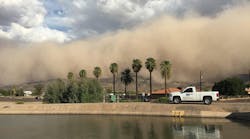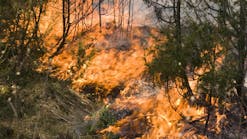Trees might not be the first thing one thinks of when considering a service territory in Arizona. However, the concepts of utility vegetation management still hold true there, especially in the face of severe weather that can affect power and water infrastructure. Imagine a massive wall of dust, thousands of feet high and sometimes many miles wide, rushing toward civilization from the vast desert surroundings. Such is the sight of an Arizona haboob, a severe dust storm that can obstruct all visibility, demolish property and damage infrastructure. The desert climate also is prone to sudden heavy bursts of torrential rainfall, complete with the lightning and winds that accompany weather front movements.
As the major supplier of electric power and water throughout the greater Phoenix, Arizona, U.S., metropolitan area and beyond, Salt River Project (SRP) maintains robust storm preparedness and vegetation management programs, which provide an active defense against the worst types of severe weather. Millions depend on the services provided by SRP, and it is the utility’s duty to ensure its services are reliable. After all, these services make it possible for millions of people to live in the desert climate of Arizona.
Strong storm response and utility vegetation management programs have helped SRP to find success throughout its nearly 115-year history. There is no better test of the effectiveness of these programs than major storm events. Responsiveness is critical for SRP to serve its customers in the wake of such storms. The utility’s No. 1 goal in the event of a storm-related outage is to restore power as quickly and safely as possible. For SRP, keeping that service commitment requires a comprehensive approach, involving several concrete steps to mitigate the risk of an outage proactively and help crews to bring back service as soon as possible.
Track Weather Patterns
Ordinary weather conditions may lead to isolated, localized outages. However, major violent and sudden storms like haboobs, or dust storms, can expose major systemic weaknesses. For instance, if an area with significant vegetation overgrowth is struck by particularly harsh conditions, the likelihood of a massive outage grows. The last thing the teams at SRP want is to be left scrambling to restore service in the affected areas.
Planning and preparation work are the heart and soul of SRP’s storm-readiness program. Key to this program is the utility’s comprehensive approach to weather tracking and prediction, a first and critical step to appropriate storm response. SRP uses several staff meteorologists for the purposes of storm tracking. This team works closely with local members of the National Weather Service (NWS), which shares offices with SRP facilities to enable close collaboration and reporting on predictive weather conditions for SRP to be ready to act when storm systems are coming.
SRP and its NWS contacts use Doppler radar, satellites and lightning-detection systems to make the most accurate storm predictions possible. These technologies are used to generate daily storm probability reports, used by SRP staff to allocate resources effectively and efficiently in real time.
For instance, outflow winds indicate the development of a storm system and make up one of the most critical metrics for storm prediction. If SRP’s daily reports pick up major indicators like these, SRP can ramp up quickly any preparation work that could be performed in advance of the storm. A daily report may indicate a severe level 1 storm is predicted for later in the day, for example, which means additional crews could be sent out to perform any necessary preparation work.
Remove Hazards
Having access to accurate weather tracking further enables SRP to be agile in working with its partners and has led to significant success in proactive as well as responsive work on the system. SRP maintains a well-structured vegetation management program aided by ACRT Inc., with which SRP has maintained a strong relationship over the last three years, along with Asplundh Tree Expert Co., a partner of SRP for more than two decades.
Like the weather in Arizona, the desert landscape is unique and offers specific challenges. As a result, the SRP vegetation management program accounts for these eccentricities. The SRP system is modern, meaning most of the power infrastructure is located underground. However, what remains aboveground is affected directly by tree growth. SRP performs full cycles to identify and remove hazard trees as a critical component of its overall program.
Plentiful throughout SRP’s service area, palm trees are most frequently the culprit of line interference, occasionally requiring pruning and removal work. However, palm trees add a striking visual presence to the Arizona landscape. As a result, they are often highly valued by homeowners throughout the area. These factors require SRP to be thoughtful, considerate and educational when it comes to communicating the necessity of tree management.
With the help of its partners, SRP developed its TREE-rific program, dedicated to helping customers understand how and why tree and line maintenance are essential components of reliable power and water service. Through the deployment of this program, SRP has helped homeowners plant these trees in strategic locations that will not become problematic in the future.
The educational component of the TREE-rific program is critical. As part of this effort, SRP makes recommendations to homeowners throughout the service area for which types of trees to plant and where in relation to power lines. SRP knows vegetation experts are not always on hand when homeowners make landscaping decisions, so fostering a greater awareness of power infrastructure and its relationship with vegetation throughout the community is a major benefit for overall system health.
Open communication with customers is another critical part of the utility’s overall vegetation management program. SRP maintains a regularly updated virtual map on its website to keep customers apprised of when and where SRP contract crews will be performing vegetation work. Whether dealing with palm trees or otherwise, the broader imperative of SRP’s vegetation management program is to remain proactive in its approach to hazard tree prevention and removal.
Whether vegetation has grown unchecked or a tree in the SRP service area has become structurally compromised, the damage a falling tree could cause within the right-of-way is significant. Contact with electrical lines or substations can cause serious damage, and in severe storm conditions, the potential for failure is heightened. For SRP, this proactive approach to hazard trees is one way the utility has made a positive impact on overall reliability.
Take Action
Once all vegetation has been managed proactively and appropriate weather monitoring has been accomplished, there is only one thing left for SRP to do in the event of severe weather: It needs to act. First, SRP quickly identifies the necessary crews for storm response, depending on the anticipated severity of the oncoming weather event. For targeted encroachments or minimal storm impacts, the SRP operations center reaches out directly to Asplundh with the identified tree work. In a widespread outage, SRP staff is called in to assist with work order dispatch and logistics.
At the end of the day, only so much can be done in anticipation of a storm that will produce 50-mph (80-kmph) winds. SRP’s teams have seen instances of major transmission poles snapped by high winds and microbursts. In instances like these, having a readily deployable plan is perhaps the single most important thing that can be done. When the worst occurs, all crews need to know their roles and must be ready to act with the proper knowledge to handle outages and damage to grid infrastructure.
SRP dispatches tree crews as soon as weather conditions allow. In some cases, it can take days to restore power in full across its 2900-sq-mile (7510-sq-km) service area. SRP has found the most effective method for restoration is to ensure all crews are rested and ready to focus on the task at hand. All SRP crews must take mandatory eight-hour rest periods as work is completed.
Enhanced Service
Established partnerships between SRP, ACRT and Asplundh have been highly beneficial in overall storm response and restoration. A utility must know the right people to call when a severe storm occurs. Further, a utility must know its partners are well versed in the proper procedures. These are valuable in ways impossible to quantify. However, they ensure swift, agile response — something on which SRP customers depend.
Overall, the SRP approach to line maintenance, storm readiness and customer service might look a bit different than in more temperate climates. Thinking ahead, learning from experience and taking a holistic, integrated approach have helped SRP to enhance service and safety across the grid. ♦
Lori Jones is manager of vegetation management in the maintenance services group at Salt River Project. She has more than a decade of management experience and more than 20 years of leadership experience. For SRP, she has led efforts to make efficiency gains in work-cycle management, inventory management and contracting services.
Check out the September 2017 issue for more articles, news and commentary.





